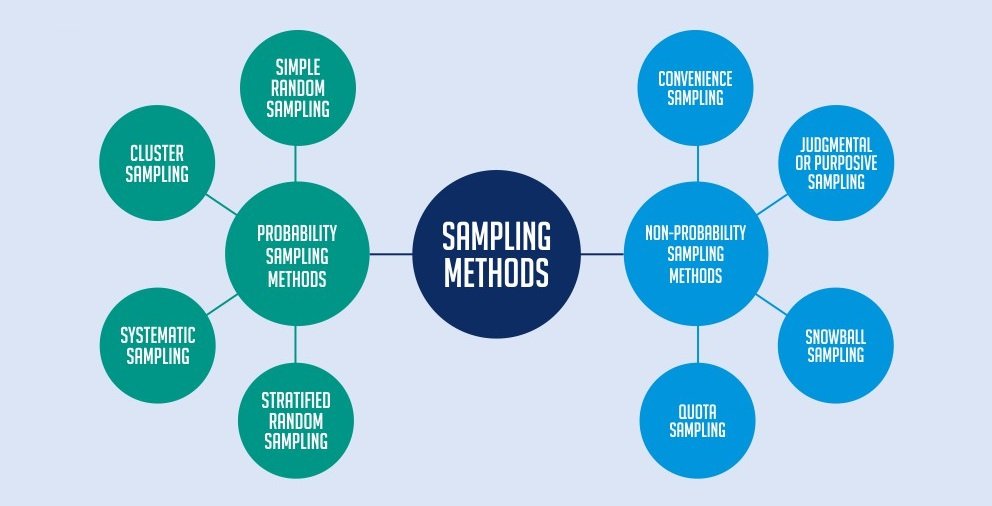Sampling Methods: Guide to All Types with Examples
Sampling is a crucial component of any research project. Selecting the right sampling method can determine the validity of your research, making it essential to choose the appropriate method for your specific question. This article delves into some of the most popular sampling methods and provides real-world examples of how they can be used to gather accurate and reliable data.
What is Sampling?
Sampling is the process of selecting individual members or a subset of a population to make statistical inferences and estimate the characteristics of the entire population. Different sampling methods allow researchers to gather insights without needing to study the entire population, making the process more time-efficient and cost-effective.
For example, if a pharmaceutical company wants to investigate the side effects of a new drug across a country, it is impractical to study the entire population. Instead, the company can select a sample from various demographics to get indicative feedback on the drug’s effects.
Types of Sampling Methods
Sampling methods can be broadly categorized into two types: probability sampling and non-probability sampling.
Probability Sampling
Probability sampling involves selecting samples from a larger population using a method based on the theory of probability. Each member of the population has an equal chance of being selected.
Types of Probability Sampling with Examples:
- Simple Random Sampling: This method involves randomly selecting individuals from the population, ensuring each member has an equal chance of being chosen.
- Example: An HR team of a company with 500 employees decides to select participants for team-building activities by drawing names from a hat. Each employee has an equal chance of being chosen.
- Cluster Sampling: Researchers divide the population into clusters, usually based on demographic factors, and then randomly select clusters to study.
- Example: To study the number of immigrants in the U.S., the government could divide the country into clusters based on states and randomly select a few states to survey.
- Systematic Sampling: This method involves selecting samples at regular intervals from a sorted list of the population.
- Example: A researcher wants to sample 500 individuals from a population of 5000. They number the population and select every 10th person to be part of the sample.
- Stratified Random Sampling: The population is divided into non-overlapping groups (strata) based on specific characteristics, and samples are taken from each group.
- Example: To analyze income levels, a researcher divides the population into income brackets (e.g., less than $20,000, $20,000-$30,000) and samples from each group to understand different income characteristics.
Uses of Probability Sampling
- Reduce Sample Bias: Probability sampling minimizes bias, leading to higher-quality data.
- Diverse Population: It ensures adequate representation of a diverse population, providing balanced insights.
- Accurate Samples: Helps in creating well-defined samples, leading to precise data collection.
Non-Probability Sampling
Non-probability sampling involves selecting samples based on the researcher’s judgment rather than random selection. This method is often used in exploratory research or when budget and time constraints are significant.
Types of Non-Probability Sampling with Examples:
- Convenience Sampling: This method involves selecting samples that are easiest to access.
- Example: NGOs distributing pamphlets at a mall entrance to promote an event, selecting participants based on convenience.
- Judgmental or Purposive Sampling: Samples are chosen based on the researcher’s knowledge and purpose of the study.
- Example: Researchers studying master’s degree aspirants may ask, “Are you interested in pursuing a master’s degree?” and select those who respond affirmatively.
- Snowball Sampling: Used for hard-to-reach populations, this method involves existing study subjects recruiting future subjects from among their acquaintances.
- Example: To study homeless populations, researchers might ask initial contacts to refer others in the same situation.
- Quota Sampling: This method involves selecting samples based on specific attributes to ensure the sample represents the population’s characteristics.
- Example: Selecting survey participants to match the demographic breakdown of a population.
Uses of Non-Probability Sampling
- Create a Hypothesis: Useful for formulating hypotheses in exploratory stages with limited prior information.
- Exploratory Research: Ideal for qualitative research, pilot studies, or when quick data collection is needed.
- Budget and Time Constraints: Efficient for initial data collection when resources are limited.

How to Decide on the Type of Sampling to Use
Choosing the appropriate sampling method is crucial for achieving your research goals. Here are steps to help you decide:
- Define Research Goals: Consider factors such as cost, precision, and accuracy.
- Identify Potential Methods: Determine which sampling techniques can help achieve your goals.
- Test Methods: Evaluate the effectiveness of each method in meeting your objectives.
- Select the Best Method: Choose the sampling method that works best for your research.
Difference Between Probability and Non-Probability Sampling Methods
| Criteria | Probability Sampling | Non-Probability Sampling |
|---|---|---|
| Definition | Based on random selection from a larger population | Based on the researcher’s judgment |
| Alternate Name | Random sampling method | Non-random sampling method |
| Population Selection | Randomly selected | Arbitrarily selected |
| Nature | Conclusive research | Exploratory research |
| Sample Representation | Demographics are conclusively represented | Demographics representation is often skewed |
| Time Taken | Longer due to defined selection parameters | Quicker due to undefined sample criteria |
| Bias in Results | Unbiased results | Biased results |
| Hypothesis | Formulated before the study | Derived after the study |
Conclusion
Understanding different sampling methods is essential for conducting effective research. These methods enable researchers to gather data efficiently and accurately without studying the entire population. By choosing the right sampling method, you can ensure the reliability and validity of your research findings. Unlock the power of accurate sampling to make informed decisions and derive actionable insights.


